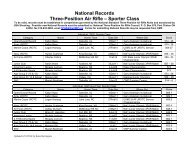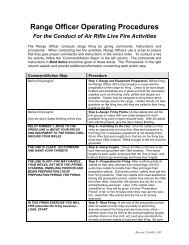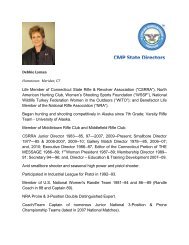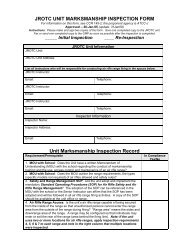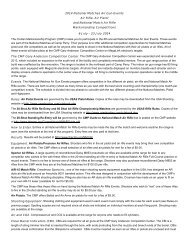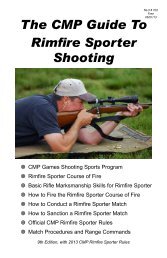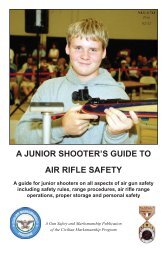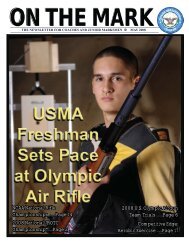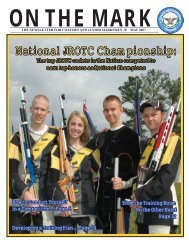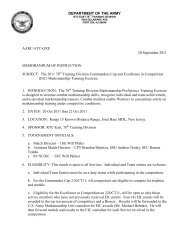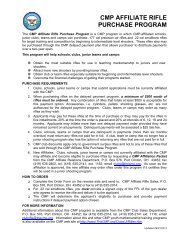summer 2010 - Civilian Marksmanship Program
summer 2010 - Civilian Marksmanship Program
summer 2010 - Civilian Marksmanship Program
Create successful ePaper yourself
Turn your PDF publications into a flip-book with our unique Google optimized e-Paper software.
JUNE <strong>2010</strong> 9<br />
CORRECTING ERRORS—SOLVING CHALLENGES FOR THE NEW SHOOTER<br />
By Gary Anderson, DCME<br />
Step 2, Head and Aiming Eye Placement. Another key to<br />
good shooting comes from being able to see the sight picture<br />
clearly. This is possible only when the rifle is placed high<br />
enough in the shoulder to keep the head reasonably erect and to<br />
allow the eye to comfortably look straightforward through the<br />
rear sight. A variation of this problem sometimes occurs when<br />
shooters who wear eyeglasses tip their heads down and end up<br />
looking over their glasses while aiming. A blurred sight picture<br />
may result. The solution is to build a position where the rifle is<br />
well up in the shoulder. For shooters who need eyeglasses to see<br />
a clear sight picture, make sure they are actually looking through<br />
their glasses while aiming.<br />
Step 3, Relaxing and Using the Rifle Support. Every good<br />
position, whether supported, standing, prone, kneeling or sitting<br />
has a means of supporting the rifle so that the muscles of the<br />
support arm (left arm for right-handed shooter) are not used to<br />
hold the rifle steady on the target. In standing, this means getting<br />
the elbow under the rifle with the arm or elbow resting on the<br />
side. For prone and kneeling, this means using the sling properly.<br />
To get sling adjustment right, you may need to go back through<br />
the steps for building the position starting with the sling adjusted<br />
loosely on the arm. After building the position, the last step is<br />
tightening the sling so it takes over the work of supporting the<br />
rifle.<br />
Step 4, Center Sight Picture Movements. Many beginners<br />
have difficulty comprehending how to deal with the large sight<br />
picture movements that are common for all beginners, especially<br />
when they try the standing position. With the front sight ring<br />
or post moving all over the entire target, they try to grab the<br />
trigger as the sight flies by the bull. The result is almost always<br />
a bad shot. Help the shooter understand that no matter how large<br />
the front sight movements are, they just need to center those<br />
movements over the target and squeeze the trigger. A good way<br />
to get this lesson across is to have the new shooter fire at a blank<br />
target with no aiming bull.<br />
Step 5, Smooth Trigger Release. Coaches with shooters<br />
who are doing poorly need to closely observe them while they<br />
fire. This will often show that the shooter is slapping the trigger<br />
like they are firing a shotgun or simply attempting to snap it as<br />
quickly as they can. Again, explain and demonstrate smooth<br />
trigger release. Dry and live firing on a blank target is a good way<br />
to focus attention on attaining a slower, smooth trigger release.<br />
A FINAL CHALLENGE--I Can’t Do This—I Don’t<br />
Want to Be Here! Every large group of new junior shooters<br />
seems to have one person with an attitude problem. This can<br />
be a challenge to turn around, but the message from the coach<br />
should always be “you can do this and I’m here to do the best I<br />
can to help you learn to shoot.” As long as an attitude problem<br />
does not become a safety issue or be disruptive to other shooters,<br />
demonstrating patience and confidence that everyone who tries<br />
can become a shooter will often turn this challenge around. Nonjudgmental<br />
acceptance can be a powerful tool in helping people<br />
change.<br />
The first shots that new shooters fire in any position are not<br />
an indication of talent or ability to shoot. They are simply an<br />
indication of whether the new shooter is applying the fundamentals<br />
of marksmanship that you are teaching them. If they don’t hit<br />
the target or they shoot bad shots, it is your responsibility as a<br />
coach to determine which fundamental is not being followed so<br />
that you can show them how to do it right. If you fulfill your<br />
responsibility, your new shooters will learn to shoot well.<br />
A big part of helping new shooters learn to apply the marksmanship<br />
fundamentals you are teaching them is to build a relationship<br />
of trust and respect that shows new shooters you believe they can<br />
learn to be good shooters.<br />
A coach who knows how to quickly detect and correct new shooter<br />
errors can ensure that the fi rst experiences in target shooting are<br />
fun and rewarding.




